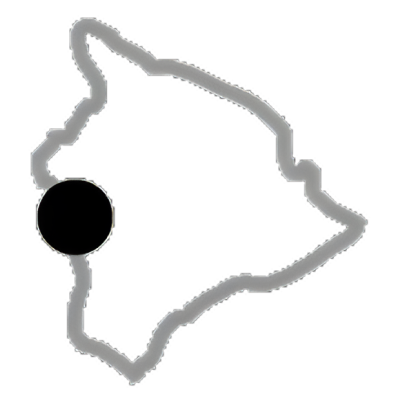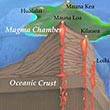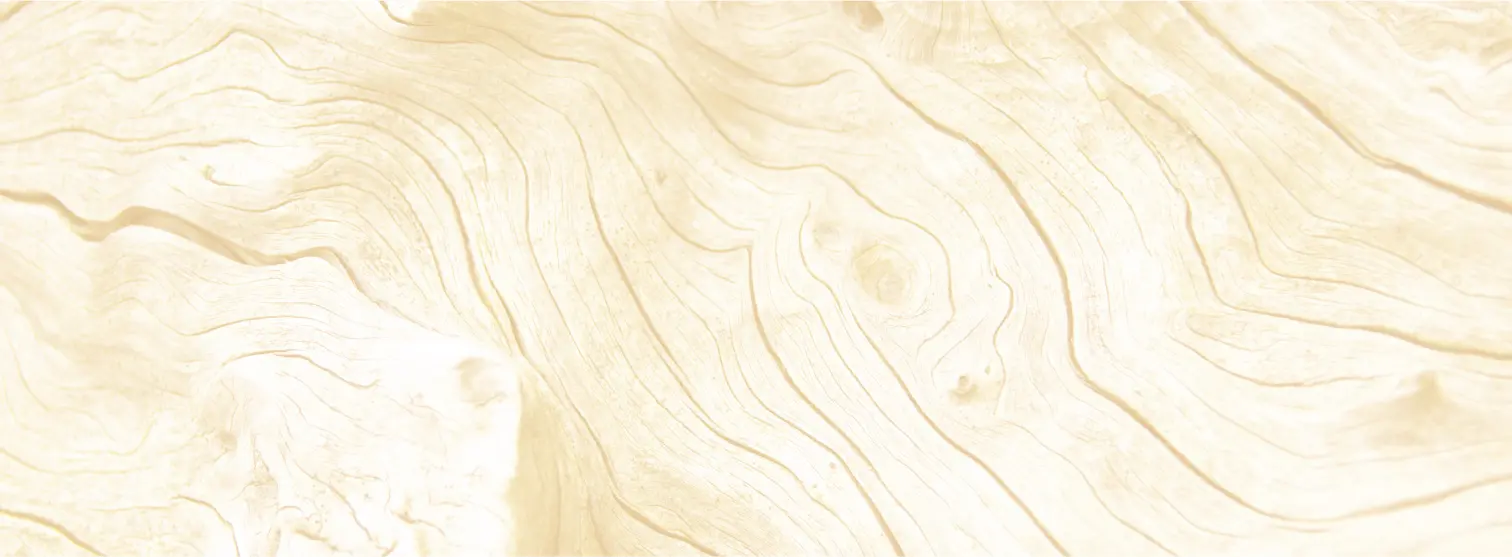The source of raw material for this age-old construction project lies more than 50 miles (80km) underground within the earth’s mantle. Here, rock kept in a plastic state by heat and pressure rises, cools, and sinks. Rising currents bring up heat from deep within the earth melting the mantle into magma. Lighter than the surrounding material the magma oozes toward the surface. As the volcanoes are pulled away from the hot spot, the rate of eruption diminishes until finally they are extinct. As they age, the islands erode and sink, until finally they disappear under the ocean.
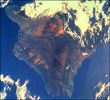
Island of Hawaii
The Big Island of Hawaii is a geologic microcosm of the entire archipelago. It has five subaerial (above the ocean) volcanoes. Like the chain, the volcanoes are oldest to the northwest and youngest to southeast.

Kohala Volcano from the south
Kohala is the oldest of five volcanoes that make up the surface of Hawaii Island. Geologists believe Kohala Volcano last erupted 60,000 thousand years ago, its oldest lava is dated at 460,000 years old. It is extinct and in the erosional stage of its life cycle. Its eastern windward flank is characterized by great erosional valleys, spectacular waterfalls, and dramatic sea cliffs. A dramatic landslide whose rubble extends fifty miles out on the ocean floor formed the sea cliffs. The summit elevation is 5480 feet or 1670 meters.

Mauna Kea
Mauna Kea is the tallest mountain in Hawaii at 13,796 feet or 4205 meters. Indeed, measured from its base off the ocean floor Mauna Kea is the tallest mountain in the world. It is dormant and last erupted around 4,500 years before present. Mauna Kea is in the post shield stage and is characterized by numerous cinder cones, two glacial valleys and an alpine glacier lake near the summit. The oldest exposed lava on Mauna Kea is about 250,000 years old. The summit is often capped with snow and is home to the greatest astronomical complex on earth.

Hualalai Summit
Rising to 8,271 feet (2521 meters), Hualalai last erupted in 1801. The lava at the Kona International Airport and at Kekaha Kai State Park is from that flow. The oldest exposed lava on the mountain is the impressive Pu’uwa’awa’a and Pu’uanahula eruption dated at 120,000 years before present. Hualalai has great well balanced features: wonderfully diverse native forest, rugged and hostile dry lowlands, incredible pit craters, surreal eruptive vents, awesome lava tubes, stark cinder highlands, an astonishing collection of archeological sites, and thousands of acres of remote inaccessible back country.

Mauna Loa, southwest rift
Mauna Loa is the world’s largest mountain. It is also one of the most active volcanoes on earth, last erupting in 1984. Mauna Loa makes up over half the surface area of the Big Island. It is in the late shield-building stage of its lifecycle. Its summit rises 13,570 (4136 meters) above sea level. New imaging technology has allowed us to see another aspect of Mauna Loa. As the volcano has built itself up off the ocean floor, it has also pushed down a mirror image into the earth’s crust. This depression extends 26,000 feet from the ocean floor. From the deepest point to its summit, Mauna Loa rises 56,000 feet!

Kilauea Summit
Kilauea is the youngest and most active volcano on the island. Indeed, it is often touted as the world’s most active volcano. Over 90% of its surface area is covered with lava less than 1500 years old. Though the summit rises to only 4093 feet (1248 meters), Kilauea continues to grow and someday may completely cover its giant neighbor Mauna Loa. The summit caldera measures two by three miles. As of this writing Kilauea enters its 21st year of near continuous eruption the longest sustained eruption recorded historically.
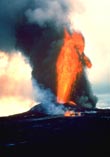
Pu’u O’o’s lava fountain
The dramatic lava fountain of Kilauea’s Pu’u O’o vent is shown in it’s early eruptive history. Pu’u’ O’o’s lava fountains attained heights as high as 1500 ft. (457m) above the crater rim. Lava fountains are propelled upward by intense expanding gases in the magma. Three of the most common volcanic features people see are pahoehoe lava, a’a lava, and cinder cones.

Pahoehoe lava
A lobe of pahoehoe slowly oozes forward. Pahoehoe is the smooth unbroken lava that looks like the top of a brownie pan. Pahoehoe is generally hotter than a’a, and contains more dissolved gases which results in a more fluid flow.

A’a lava
An advancing flow of a’a lava crushes a deserted pick-up truck. A’a is the jagged, broken lava that looks like it was bulldozed. It is more viscous than pahoehoe. Similar to a river freezing the cooling chunks on the surface are ‘rafted’ along with the molten mass.

Cinder cones
Cinder cones of Mauna Kea on the Pohakuloa saddle. Cones are characteristic of late stage eruptions within the long life cycle of a volcano. Each one is an eruptive event in the volcano’s distant past. High gas content propels lava skyward, which then falls back to the ground in small-frozen’ pieces; like lava popcorn.

Steam plumes
Steam plumes arise as molten lava enters the ocean. Transported down slope in underground tubes the lava hits the water at nearly 2000 degrees F. forming new benches of lava. The steam plume, called laze, is a form of hydrochloric acid and contains microscopic particles of glass. Extreme heat and violent water, plus the threat of lava bench collapses, make these lava entry areas very dangerous.
CREDITS – National Geographic: Hawaii’s volcanoes; USGS: Island of Hawaii, Kohala Volcano from the south, Mauna Kea, Hualalai Summit, Mauna Loa, Kilauea Summit, Pahoehoe lava, A’a lava; Carl Waldbauer: Cinder cones; Jack Jeffrey: Pu’u O’o’s lava fountain Steam plumes
